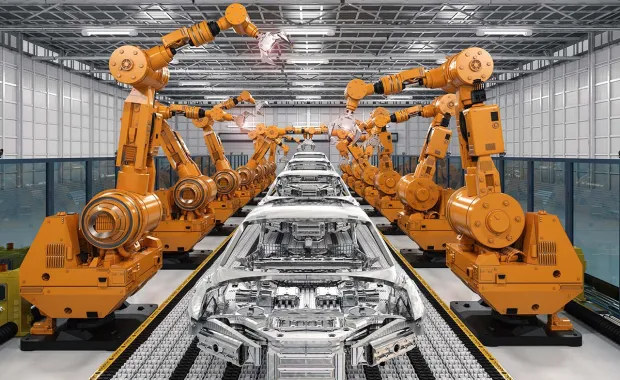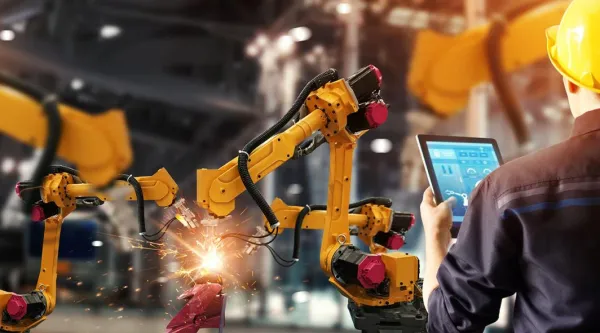Circular economies have become central to discussions about addressing climate change and building a sustainable future in manufacturing. This article summarizes a recent panel discussion during the Power of Unified Manufacturing event on the concept of circular economies and the pivotal role of data sharing in facilitating the transition.
The panelists included Adrian von Mühlenen, BASF; Philipp Leschinski, BMW; Melanie Luckey and Virgil Raibulet, Henkel; Joerg Walden, iPoint-systems, Holger Berg, Wuppertal Institute and Marco Burk and Ralf Schippert, CGI.
Growing importance of the circular economy
Today, sustainability is a strategic priority for manufacturers. According to Holger, circular economies are a way for companies to become more sustainable, from a resource and an energy perspective. Regulations, especially in the European Union, are also driving this focus. Moreover, circular economies offer a compelling proposition to help address supply chain and material shortages and enable manufacturers to rethink how they build and sell products and create new business models.
Circular economies are predicated on the idea of a diverse range of companies joining forces for a common aim—not just from an ecological standpoint but an economic one too. This is true, particularly for smaller companies, for whom circular economies offer several financial benefits, including potential savings on material costs and new business models like recycling and remanufacturing materials.
Holger cites glass and metal recycling as examples, adding that refurbishment is another area that can be scaled quickly to gain significant sustainability outcomes. However, regardless of the collective objectives, data is the core enabler in this transition.
Critical role of data
Data models that enable the open exchange and sharing of information are essential for a circular economy to function. At the same time, data must be contextualized to provide actionable insights. "We have to refine it [data] to go up the pyramid: data, information, knowledge, wisdom," states Adrian. To enable this, "we need to have the same standard language to easily exchange information between the different stakeholders. We need to have data interoperability." Data interoperability allows manufacturers to easily connect between various master data management systems and gain the insight needed to develop methodologies and common rulebooks to understand their carbon footprint.
In the case of Catena X, a rulebook was first built to define and set these standards to assess a product's carbon footprint. Now, it is being used to develop a data model for battery passports. "It's the so-called information model where we are completely system agnostic, but we can describe the different entities and the relationships [within it]," Adrian says.
For BASF, which is entering the battery recycling business, this will allow the company to establish—together with the industry—the same data language and track and trace required information. Adrian explains that this data will enable them to build a digital twin to track product information over its lifetime. This data can then be used to make informed decisions on how parts can be reused when they reach end of life.
Breaking down silos
Data is the enabler, but leveraging it has challenges. Organizations tend to work in silos that become magnified across the entire value chain. Siloed ways of working impede the ability to share data and become data-driven organizations. Closing data gaps and transforming into a circular economy requires holistic change across the organization, including the data system and the thinking of everyone involved.
There are, of course, day-to-day challenges in exchanging data, including numerous APIs, data and business models. As a result, currently, there is no real interoperability, says Adrian.
Product passport
Data is central to the concept of "digital product passports." Virgil explains that product passports give the recycler or the re-manufacturer visibility into what comprises this product, years and years from the date of manufacture, by breaking down a product into its components with information regarding how those materials can be reused. He adds that Henkel is keen to ensure this level of transparency and equally requires it from their suppliers. "We want the standardized data, and we want these ecosystems where suppliers have the incentive to connect," he says. The alternative is to connect with every customer, which is unfeasible.
He explains that this deep level of product transparency enables the end-of-life of products to be meaningful as it supports remanufacture, reuse or recycling. "It is key to work across the entire value chain and get the data to the ecosystem to ensure we have the transparency to achieve a circular economy," Melanie adds.
However, accessing relevant data and generating the correct information is an important but complex issue. For example, a material deemed "safe" 20 years ago may now be considered toxic and unsafe for recycling. Varying regulations and compliance requirements across industries, regions and countries add another layer of complexity.
Establishing trust within ecosystems
Adding to the challenge, Marco says numerous participants are involved in creating circular economies, and trust underpins their ability to work together. Ralf agrees that while data platforms and IT systems can connect participants, it comes down to trusting the data from such ecosystems. Virgil adds that circular economy networks are far more complex than traditional supply chains: "For them to work, we need the acceptance and the will from all the actors involved to share their data and the information to some extent."
There may be resistance to sharing data, especially when IP is involved. Many companies struggle to share relevant data while still protecting their USP. The challenge is finding a way to share the right information with the right parties while safeguarding business value. The openness to sharing data correlates to product complexity. The risk of sharing reduces significantly when it is a simple product, says Ralf. He describes the "one-up, one-down" practice followed in Catena-X, where manufacturers have transparency with their direct suppliers and not the whole network.
Addressing ecosystem-related cybersecurity risks
The 2022 CGI Voice of Our Clients research reveals that while 65% of executives interviewed have implemented an enterprise-wide cybersecurity strategy, just 29% have extended it to their external ecosystem. With organizations moving to more complex ecosystems, cybersecurity has also increased in complexity. However, circular economies could provide an answer for smaller organizations that haven't yet been able to invest in cybersecurity. By joining such ecosystems, they can start benefiting from the security tools provided by others when building the network.
Marco likens this scenario to the move to the cloud. "Initially, people said there might be security issues because data is now somewhere else. But reality has shown that the security measures in a cloud environment are typically much higher than what companies had in the past," he says. He adds that ecosystems underpinned by strong partnerships can support stable and secure environments.
Watch the webinar





